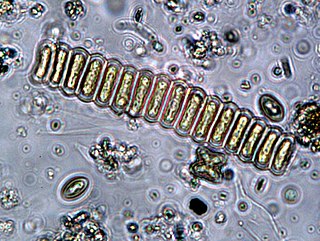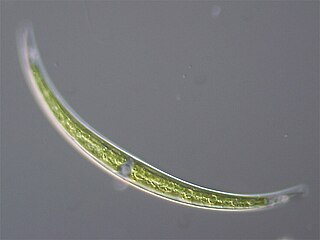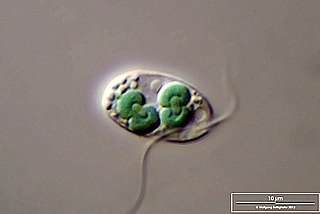
Sphaeropleales is an order of green algae that used to be called Chlorococcales. The order includes some of the most common freshwater planktonic algae such as Scenedesmus and Pediastrum. The Sphaeropleales includes vegetatively non-motile unicellular, colonial, or filamentous taxa. They have biflagellate zoospores with flagella that are directly opposed in direction : Sphaeroplea, Atractomorpha, Neochloris, Hydrodictyon, and Pediastrum. All of these taxa have basal body core connections. Motile cells generally lack cell walls or have only a very fine layer surrounding the cell membrane. Other common characteristics include a robust vegetative cell wall, cup-shaped chloroplasts with large pyrenoids, and relatively large nuclei.
Prymnesium parvum is a species of haptophyte. The species is of concern because of its ability to produce the phycotoxin prymnesin. It is a flagellated alga that is normally found suspended in the water column. It was first identified in North America in 1985, but it is not known if it was introduced artificially or missed in previous surveys. Toxin production mainly kills fish and appears to have little effect on cattle or humans. This distinguishes it from a red tide, which is an algal bloom whose toxins lead to harmful effects in people. Although no harmful effects are known, it is recommended not to consume dead or dying fish exposed to a P. parvum bloom.
Neochloris oleoabundans is a microalga belonging in the class Chlorophyceae. Due to its high lipid content, it has been considered as a candidate organism for cosmetics and biofuel production, as well as feed stock for freshwater mussels.

Navicula is a genus of boat-shaped diatom algae, comprising over 1,200 species. Navicula is Latin for "small ship", and also a term in English for a boat-shaped incense-holder.

Bodo is a genus of microscopic kinetoplastids, flagellate excavates first described in 1831 by Christian Gottfried Ehrenberg. The genus is small, as it has recently been redefined to include only four species. Bodo includes free-living, phagotrophic organisms that can be found in many marine and freshwater environments as well as some terrestrial environments. Being phagotrophic, Bodo feeds on bacteria and other microorganisms that it finds while swimming through its water-based habitats. The swimming-like movement is facilitated by the two unequal flagella that Bodo possesses which arise from an anteriorly located flagellar pocket. Bodo is roughly bean-shaped and is often missed in samples from water or terrestrial environments due to its small size.

Scenedesmus is a genus of green algae, in the class Chlorophyceae. They are colonial and non-motile. They are one of the most common components of phytoplankton in freshwater habitats worldwide.

Botryococcus is a genus of green algae. The cells form an irregularly shaped aggregate. Thin filaments connect the cells. The cell body is ovoid, 6 to 10 μm long, and 3 to 6 μm wide. Fossils of the genus are known since Precambrian times, and form the single largest biological contributor to crude oil, and are a major component of oil shales.

Ankistrodesmus is a genus of green algae in the family Selenastraceae. It is one of the most common types of phytoplankton in freshwater habitats around the world.
Raphidocelis is a genus of green algae in the family Selenastraceae. They are found in freshwater habitats.

Selenastrum is a genus of green algae in the family Selenastraceae. It is common in freshwater habitats around the world. Most species prefer temperate or warm-temperate waters.

Closterium is a genus of desmid, a group of charophyte green algae. It is placed in the family Closteriaceae. Species of Closterium are a common component of freshwater microalgae flora worldwide.

Tetrastrum is a genus of green algae (Chlorophyta). It is a common component of the phytoplankton of freshwater habitats, particularly eutrophic and alkaline waters.

Chlorokybus is a multicellular (sarcinoid) genus of basal green algae or charophyte. It has been classified as the sole member of the family Chlorokybaceae, which is the sole member of the order Chlorokybales, in turn the sole member of the class Chlorokybophyceae. It grows on soil and rock surfaces, and is rare.

Nannochloropsis is a genus of algae comprising six known species. The genus in the current taxonomic classification was first termed by Hibberd (1981). The species have mostly been known from the marine environment but also occur in fresh and brackish water. All of the species are small, nonmotile spheres which do not express any distinct morphological features that can be distinguished by either light or electron microscopy. The characterisation is mostly done by rbcL gene and 18S rRNA sequence analysis.

Ornithocercus is a genus of planktonic dinoflagellate that is known for its complex morphology that features considerable lists growing from its thecal plates, giving an attractive appearance. Discovered in 1883, this genus has a small number of species currently categorized but is widespread in tropical and sub-tropical oceans. The genus is marked by exosymbiotic bacteria gardens under its lists, the inter-organismal dynamics of which are a current field of research. As they reside only in warm water, the genus has been used as a proxy for climate change and has potential to be an indicator species for environmental change if found in novel environments.

Cyanophora paradoxa is a freshwater species of Glaucophyte that is used as a model organism. C. paradoxa has two cyanelles or chloroplasts where photosynthesis occurs. Cyanelles are unusual organelles in that they retain a rudimentary peptidoglycan wall. The cyanelle genome of C. paradoxa strain LB 555 was sequenced and published in 1995. The nuclear genome was also sequenced and published in 2012.

An autospore is a non-motile (non-flagellated) aplanospore that is produced within a parent cell, and has the same shape as the parent cell, before release. Autospores, zoospores, and aplanospores, are the three types of spores that algae use to reproduce and spread asexually. Autospores occur in several groups of algae, including Eustigmatophyceae, Dinoflagellates, and green algae. For example, the colonial alga Dichotomococcus produces two autospores per reproducing cell; the autospores escape through a slit in the cell wall and remain attached to the mother cell.
Galdieria sulphuraria is an extremophilic unicellular species of red algae. It is the type species of the genus Galdieria. It is known for its broad metabolic capacities, including photosynthesis and heterotrophic growth on over 50 different extracellular carbon sources. The members of the class Cyanidiophyceae are among the most acidophilic known photosynthetic organisms, and the growth conditions of G. sulphuraria – pH between 0 and 4, and temperatures up to 56 °C – are among the most extreme known for eukaryotes. Analysis of its genome suggests that its thermoacidophilic adaptations derive from horizontal gene transfer from archaea and bacteria, another rarity among eukaryotes.

Tetradesmus obliquus is a green algae species of the family Scenedesmaceae. It is commonly known by its synonym, Scenedesmus obliquus. It is a common species found in a variety of freshwater habitats.

Chlorella vulgaris is a species of green microalga in the division Chlorophyta. It is mainly used as a dietary supplement or protein-rich food additive in Japan.














